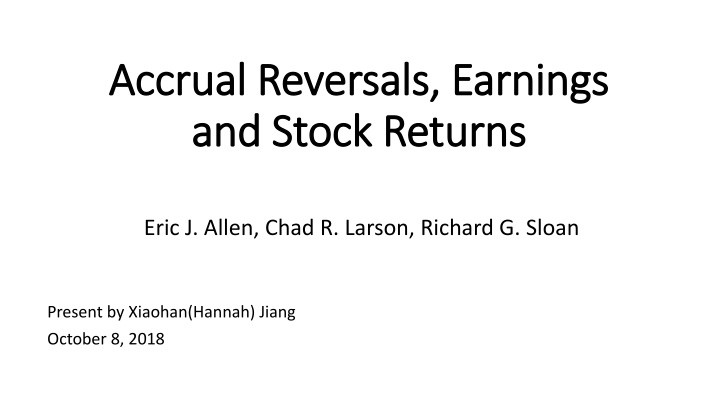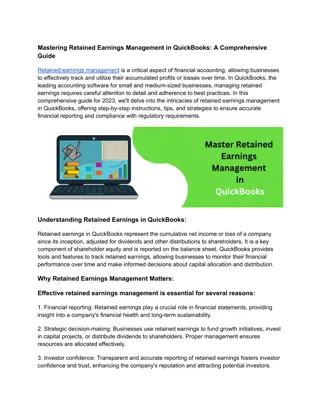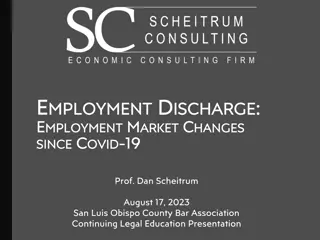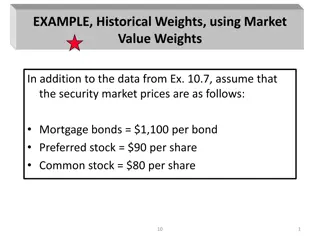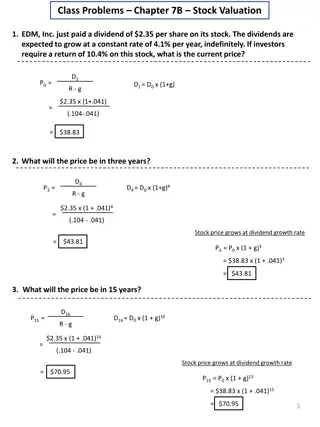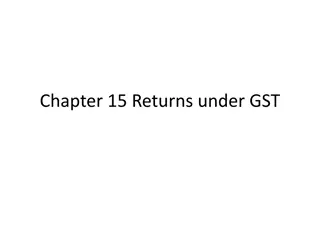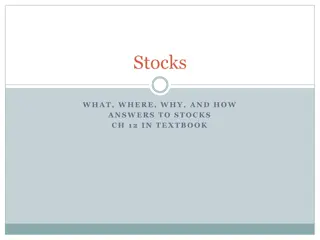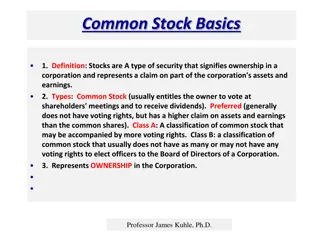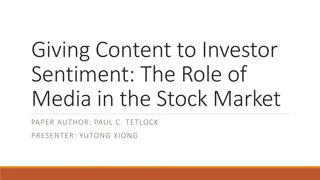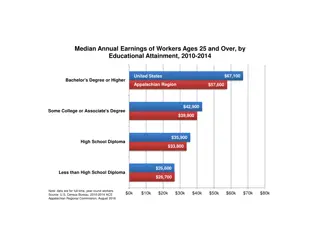Accrual Reversals, Earnings and Stock Returns
This study by Eric J. Allen, Chad R. Larson, and Richard G. Sloan examines the relationship between accrual reversals, earnings, and stock returns. The research delves into the impact of these factors on financial performance and market valuation, offering insights into the dynamics of financial reporting and investor expectations.
Download Presentation

Please find below an Image/Link to download the presentation.
The content on the website is provided AS IS for your information and personal use only. It may not be sold, licensed, or shared on other websites without obtaining consent from the author.If you encounter any issues during the download, it is possible that the publisher has removed the file from their server.
You are allowed to download the files provided on this website for personal or commercial use, subject to the condition that they are used lawfully. All files are the property of their respective owners.
The content on the website is provided AS IS for your information and personal use only. It may not be sold, licensed, or shared on other websites without obtaining consent from the author.
E N D
Presentation Transcript
Accrual Reversals, Earnings Accrual Reversals, Earnings and Stock Returns and Stock Returns Eric J. Allen, Chad R. Larson, Richard G. Sloan Present by Xiaohan(Hannah) Jiang October 8, 2018
What is accrual and why accrual reversal is What is accrual and why accrual reversal is important? important? An adjustment method that recognizes income when earned and expenses when incurred regardless of when cash is received or disbursed. eg: inventory, accounts receivable, PP&E and goodwill, pension liabilities etc. This paper: only focus on current accruals! Will reverse when: i. anticipated future benefits are realized or ii. new evidence indicates that benefits are unlikely to be realized.
What is accrual and why accrual reversal is What is accrual and why accrual reversal is important? important? Accrual reversals can be employed in test of earnings management. Ending shareholders equity = Beginning shareholders equity + Net income + Other comprehensive income - Dividends declared Read more: https://www.investopedia.com/university/accounting-earnings-quality/earnings3.asp#ixzz5THRv2ncP
What is accrual and why accrual reversal is What is accrual and why accrual reversal is important? important? Accrual Anomaly (Sloan 1996): Refers to the negative relationship between accounting accruals and subsequent stock returns. Sloan s paper found that shares in companies with small or negative accrual ratios vastly outperform (+10% annually) those of companies with large ones. More on: Do Stock Prices Fully Reflect Information in Accruals and Cash Flows about Future Earnings? (Richard G. Sloan 1996)
Main Model and Variables Overview Main Model and Variables Overview Decompose accruals into three components: 1) Good accruals relating to firm Growth 2) Good accruals relating to temporary fluctuations in working capital 3) Accrual estimation error Most previous research(established in Jones 1991) decompose into: 1) Normal accruals relating to firm growth 2) Abnormal accruals unrelating to firm growth Key Distinction: involves an ex post evaluation of whether an accrual correctly anticipates a future benefits.
MDD Model and Variables Overview MDD Model and Variables Overview ACCt = Current non-cash asset current operating liabilities SGRt = (Salest-Salest-1)/Salest-1 EMPGRt = (Employeest-Employeest-1)/Employeest-1 CF = Income Accruals All the financial variables in sample are scaled by average total assets. MDD: proposed by Dechow and Dichev(2002),modified by Bushman et al.(2011)
Three Empirical Predictions Three Empirical Predictions P1: Good accruals consist of two distinct processes. One positively serially correlated process representing persistence in firm growth. One negatively serially correlated process representing temporary fluctuations in working capital. P2: The lower persistence of accrual component of earnings is attributable to accrual estimation error. P3: The negative relation between accruals and future stock returns is attributable to accrual estimation error.
P1: Good accruals consist of two distinct processes: P1: Good accruals consist of two distinct processes:
P1: Good accruals consist of two distinct processes: P1: Good accruals consist of two distinct processes: Table1 ACC displays weak positive serial correlation, CF and INC display strong positive serial correlation. Negative correlation between ACCt and CFtis consistent with good accruals that offset the impact of temporary fluctuations in working capital on cash flows. ACCt negatively correlated with RETt+1 well known accrual anomaly .
P1: Good accruals consist of two distinct processes: P1: Good accruals consist of two distinct processes:
P1: Good accruals consist of two distinct processes: P1: Good accruals consist of two distinct processes: Table 2: Quintile portfolio transition matrices between current year and subsequent year. If there is no serial correlation or temporal dependency, each cell will be exactly 4%. Simple positive serial correlation leads to greater proportion fall in/around main diagonal cells, while negative correlation leads to fall in minor diagonal cells.
P1: Good accruals consist of two distinct processes: P1: Good accruals consist of two distinct processes:
P1: Good accruals consist of two distinct processes: P1: Good accruals consist of two distinct processes: Table 3: Panel A: Partial R-squares for MDDMATCH(0.45) is greater than MDDGROWTH(0.127), R-squares for MDDGOOD is 0.5 Temporary fluctuation component is more economically significant that growth component. MDD model does a reasonably good job at explaining variation in accruals. Panel B: Good accruals(MDDGOOD) : negative serial correlation(-0.37) MDDGROWTH(-0.565) contributes most to MDDGOOD negative sign. MDDMATCH(0.361),positive. Prediction 1 verified again. MDDEROOR(0.223) is positively serially correlated! Error take longer than one period to reverse or Positive correlated good accruals are misclassified as estimation error
P1: Good accruals consist of two distinct processes: P1: Good accruals consist of two distinct processes: Time-series properties of accruals:
P1: Good accruals consist of two distinct processes: P1: Good accruals consist of two distinct processes: Panel A: Latent class mixture models Expect to observe at least 2 distinct clusters in accrual autoregressions if prediction one is true. Coefficients diverse as adding more clusters Panel B: Relate each cluster to hypothesized economic determinants Cluster 1 should have strongest relation to MDDGROWTH Partial R-square for MDDGROWTH is the largest. Cluster 2&3 should have stronger relations with MDDMATCH Partial R-squares are larger.
P2: The lower persistence of accrual P2: The lower persistence of accrual component of earnings is attributable to component of earnings is attributable to accrual estimation error. accrual estimation error. Lower persistence of accrual: Firm with higher accruals tends to be less profitable in the future. This link between accruals and future profitability, is often characterized by saying that accruals are less persistent than cash flows
P2: The lower persistence of accrual component of earnings is P2: The lower persistence of accrual component of earnings is attributable to accrual estimation error. attributable to accrual estimation error.
P2: The lower persistence of accrual component of earnings is P2: The lower persistence of accrual component of earnings is attributable to accrual estimation error. attributable to accrual estimation error. Table 5 results: Panel A: the coefficient on ACCt (0.685) is lower than the coefficient on CFt (0.843). Lower persistence. Panel B: The coefficient on MDDERRORt is 0.330 while the coefficients on CFt and MDDGOODt are 0.902 and 1.125 respectively. Lower persistence attributable to estimation error. Panel C: Omit CFt+1 to deal with mechanical positive correlation between MDDMATCHt and INCt+1 Note MDDMATCH do not contribute to the power persistence!
P3: The negative relation between accruals P3: The negative relation between accruals and future stock returns is attributable to and future stock returns is attributable to accrual estimation error. accrual estimation error.
P3: The negative relation between accruals and future stock P3: The negative relation between accruals and future stock returns is attributable to accrual estimation error. returns is attributable to accrual estimation error. Table 6 results: Panel A: Accrual anomaly, while it is statistically insignificant because of the design of the model. Panel B: Negative relation between accruals and future stock returns is primarily attributable to MDDERROR. Prediction 3 Panel C: Omit CFt+1, to decompose accruals.
Inventory Write Inventory Write- -Down Results Down Results Inventory write-downs represent reversals of prior positive accrual estimation errors. If the MDD models is successful at isolating accrual estimation errors and their subsequent reversals, we expect to find relation: The Year of write-down The year before write down Corr(MDDERROR, write- downs) Positive Negative
Inventory Write Inventory Write- -Down Results Down Results
Conclusions Conclusions Accruals consist of two distinct process, a persistent process that reflects firm growth, and a reversing process that reflects temporary fluctuations in working capital. Most accrual reversals represent good accruals that correctly anticipate temporary fluctuations in working capital Accrual estimation error is the least persistent component of earnings
Why the findings are important? Why the findings are important? Previous research has modeled accruals as consisting of a single white noise process. Incorrect! They consist of at least two distinct processes. Researchers have overlooked important economic characteristics of accounting data. Findings have implication for earnings management The lower persistence of accrual component of earnings and associated mispricing appear to be driven by accrual estimation error and firm growth Identifies puzzles and opportunities for additional research Unable to document systematic evidence of adjacent year reversals in firm level estimation errors.
Remarks Remarks The paper did a good job in showing that accruals consist of two distinct processes. It is a good explanation model overall. Concern about their methods of bringing future cash flow into their models. After excluding CFt+1, some explanations are vague to me. A little bit disappointing that it has little to do with trading strategy. Would be more happier if author can shed more light on earnings management.
Thanks! Thanks!
